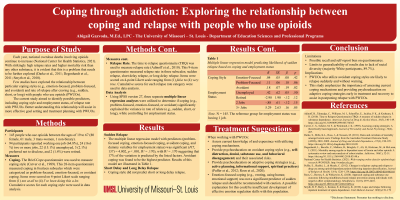Back


(63) Exploring the Relationship Between Coping and Relapse with People Who Use Opioids
Saturday, April 6, 2024
9:45 AM – 1:15 PM

Has Audio

Abigail Gazvoda, M.Ed., LPC
Mental Health Therapist
The University of Missouri - St. Louis, Missouri
Presenter(s)
Background & Introduction: People who use opioids (PWUOs) experience higher relapse and overdose death rates compared to those who use other substances (National Center for Health Statistics, 2021). Many risk factors and predictors for relapse have been identified with this population such as reduced access to healthcare, injection drug use, low self-efficacy, etc. (Calvert et al., 2021; Naji et al., 2022; Sureshkumar et al., 2021). However, more specific and recent data is needed to clarify time to relapse with this population and to explore if there are specific types of coping that may delay relapse with this population. This study will use data collected from two self-report questionnaires to explore these variables further. More specifically, this study will explore the relationship between coping style and rate of relapse with those who use opioids. With the main research question being "Does coping style predict time to relapse for people who use opioids?"
Methods: Participants were recruited from the community through convenience and snowball sampling, via advertising flyers posted at local Narcotic Anonymous meeting locations, flyers posted at recovery homes, and online announcements. The survey collected information regarding demographics, substance use history, coping via the Brief-COPE questionnaire, and relapse rate via the time to relapse questionnaire (TRQ).
The study population (n = 145) consisted of individuals who have a history of misusing opioids in the United States. A power analysis was conducted using the G*Power 3.1 program to compute achieved power. With a total sample size of 145, effect size of .15, and alpha error probability of .005, power achieved was .937 (Faul et al., 2009). Eligibility criteria included being 18 years or older and with a history of opioid misuse. Participants were excluded from the study if they were under 18 years old, struggled with substances not including opioids, or if they could not provide consent.
Data analysis was conducted using SPSS version 27. Multiple linear regression analyses were conducted to examine the relationship between rate of relapse and predictor variables (problem-focused coping, emotion-focused coping, and avoidant coping).
Results: The results of the first model supported the hypothesis that avoidant coping (𝛽=.175, p < .05) is a predictor of sudden relapse. However, models which examined short and long relapse were insignificant and hypotheses were rejected.
Conclusion & Discussion: The purpose of the study was to explore the relationship between specific coping styles (avoidant, emotion-focused, and problem-focused) and relapse rate (sudden, short, or delayed). The results indicated that there was a significant and positive relationship between avoidant coping and sudden relapse. Therefore, individuals who use avoidant coping strategies seem to relapse sooner and without warning. These findings emphasized the importance of continued assessment of coping mechanisms throughout substance use treatment and early in recovery and the continued psychoeducation regarding specific coping mechanisms that may precipitate relapse. Further research is needed to explore short and long relapse, specifically long relapse which could provide PWUOs and addiction professionals with increased time for interventions (Fathi et al., 2020; Shi et al., 2009).
References:
Calvert, J. M., Dickson, M. F., Tillson, M., Pike, E., & Staton, M. (2021). Rural re-entry and opioid use: Identifying health-related predictors of relapse among formerly incarcerated women in Appalachia. Journal of Appalachian Health, 3(3), 22–35. https://doi.org/10.13023/jah.0303.03.
Fathi, H., Yoonessi, A., Ardani, A. R., Majdzadeh, R., Rezaeitalab, F., & Cerniglia, L. (2020). Effects of abstinence from opioids on self-reported craving and sleep. Cogent Psychology, 7(1), 1–11. https://doi.org/10.1080/23311908.2020.1713440
Faul, F., Erdfelder, E., Buchner, A., & Lang, A. (2009). Statistical power analyses using G*Power 3.1: Tests for correlation and regression analyses. Behavior Research Methods, 41, 1149-1160.
National Center for Health Statistics. (2021). Wide-ranging online data for epidemiologic research (WONDER). https://wonder.cdc.gov.
Naji, L., Rosic, T., Worster, A., Thabane, L., Samaan, Z., Sanger, N., Dennis, B., Hillmer, A., Hudson, J., Paul, J., & Marsh, D. C. (2022). Cannabis use and opioid relapse: An exploratory survival analysis of prospectively collected data. Frontiers in Psychiatry, 13. https://doi.org/10.3389/fpsyt.2022.1046649
Shi, J., Li, S., Zhang, X., Wang, X., Foll, B. L., Zhang, X.-Y., Kosten, T. R., & Lu, L. (2009). Time-dependent neuroendocrine alterations and drug craving during the first month of abstinence in heroin addicts. American Journal of Drug & Alcohol Abuse, 35(5), 267–272. https://doi.org/10.1080/00952990902933878
Sureshkumar, K., Kailash, S., Dalal, P., & Rudhran, V. (2021). Relapse in opioid dependence: Role of psychosocial factors. Indian Journal of Psychiatry, 63(4), 372-376. https://doi.org/10.4103/psychiatry.IndianJPsychiatry_383_20.
Methods: Participants were recruited from the community through convenience and snowball sampling, via advertising flyers posted at local Narcotic Anonymous meeting locations, flyers posted at recovery homes, and online announcements. The survey collected information regarding demographics, substance use history, coping via the Brief-COPE questionnaire, and relapse rate via the time to relapse questionnaire (TRQ).
The study population (n = 145) consisted of individuals who have a history of misusing opioids in the United States. A power analysis was conducted using the G*Power 3.1 program to compute achieved power. With a total sample size of 145, effect size of .15, and alpha error probability of .005, power achieved was .937 (Faul et al., 2009). Eligibility criteria included being 18 years or older and with a history of opioid misuse. Participants were excluded from the study if they were under 18 years old, struggled with substances not including opioids, or if they could not provide consent.
Data analysis was conducted using SPSS version 27. Multiple linear regression analyses were conducted to examine the relationship between rate of relapse and predictor variables (problem-focused coping, emotion-focused coping, and avoidant coping).
Results: The results of the first model supported the hypothesis that avoidant coping (𝛽=.175, p < .05) is a predictor of sudden relapse. However, models which examined short and long relapse were insignificant and hypotheses were rejected.
Conclusion & Discussion: The purpose of the study was to explore the relationship between specific coping styles (avoidant, emotion-focused, and problem-focused) and relapse rate (sudden, short, or delayed). The results indicated that there was a significant and positive relationship between avoidant coping and sudden relapse. Therefore, individuals who use avoidant coping strategies seem to relapse sooner and without warning. These findings emphasized the importance of continued assessment of coping mechanisms throughout substance use treatment and early in recovery and the continued psychoeducation regarding specific coping mechanisms that may precipitate relapse. Further research is needed to explore short and long relapse, specifically long relapse which could provide PWUOs and addiction professionals with increased time for interventions (Fathi et al., 2020; Shi et al., 2009).
References:
Calvert, J. M., Dickson, M. F., Tillson, M., Pike, E., & Staton, M. (2021). Rural re-entry and opioid use: Identifying health-related predictors of relapse among formerly incarcerated women in Appalachia. Journal of Appalachian Health, 3(3), 22–35. https://doi.org/10.13023/jah.0303.03.
Fathi, H., Yoonessi, A., Ardani, A. R., Majdzadeh, R., Rezaeitalab, F., & Cerniglia, L. (2020). Effects of abstinence from opioids on self-reported craving and sleep. Cogent Psychology, 7(1), 1–11. https://doi.org/10.1080/23311908.2020.1713440
Faul, F., Erdfelder, E., Buchner, A., & Lang, A. (2009). Statistical power analyses using G*Power 3.1: Tests for correlation and regression analyses. Behavior Research Methods, 41, 1149-1160.
National Center for Health Statistics. (2021). Wide-ranging online data for epidemiologic research (WONDER). https://wonder.cdc.gov.
Naji, L., Rosic, T., Worster, A., Thabane, L., Samaan, Z., Sanger, N., Dennis, B., Hillmer, A., Hudson, J., Paul, J., & Marsh, D. C. (2022). Cannabis use and opioid relapse: An exploratory survival analysis of prospectively collected data. Frontiers in Psychiatry, 13. https://doi.org/10.3389/fpsyt.2022.1046649
Shi, J., Li, S., Zhang, X., Wang, X., Foll, B. L., Zhang, X.-Y., Kosten, T. R., & Lu, L. (2009). Time-dependent neuroendocrine alterations and drug craving during the first month of abstinence in heroin addicts. American Journal of Drug & Alcohol Abuse, 35(5), 267–272. https://doi.org/10.1080/00952990902933878
Sureshkumar, K., Kailash, S., Dalal, P., & Rudhran, V. (2021). Relapse in opioid dependence: Role of psychosocial factors. Indian Journal of Psychiatry, 63(4), 372-376. https://doi.org/10.4103/psychiatry.IndianJPsychiatry_383_20.
Learning Objectives:
- Describe common coping mechanisms used by people who use opioids.
- Compare specific coping mechanisms and their relationship to relapse rate with people who use opioids.
- Formulate effective treatment plans that utilize the most helpful coping mechanisms for preventing relapse.
